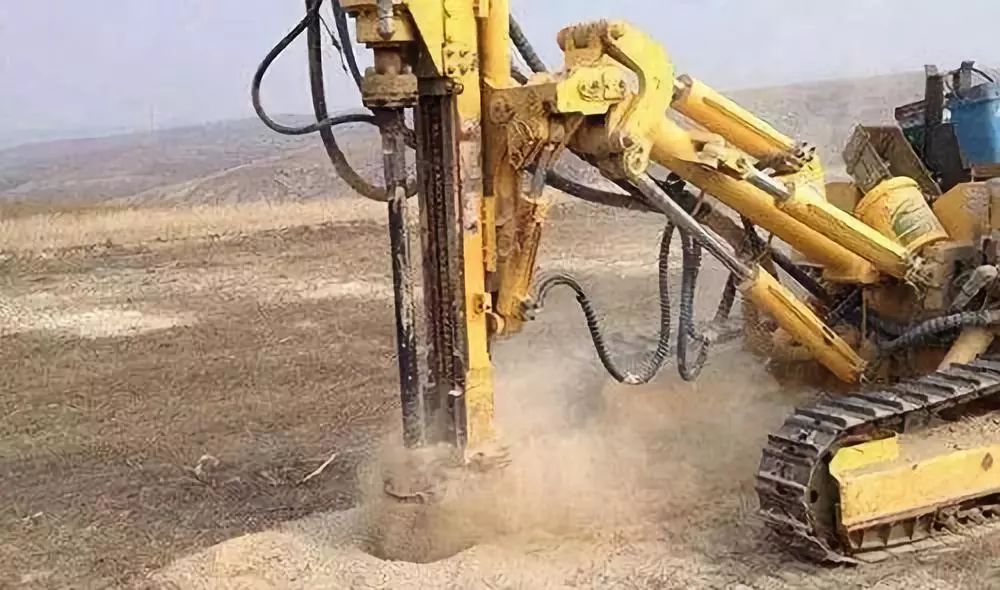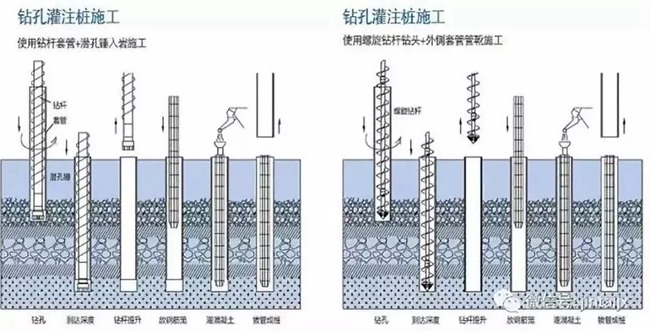The steel casing wall protection is used during the hole-forming process of the cast-in-place piles drilled by the full-casing and full-rotation drilling rig. It has the characteristics of good pile quality, no mud pollution, green ring, and reduced concrete filling coefficient. It can effectively solve problems such as hole collapse, necking, and high filling coefficient that occur when ordinary construction methods are used to construct cast-in-place piles in urban high-fill and karst landforms. It is currently used in bridges, buildings, petrochemicals, and other construction fields.
1. Full-rotation cast-in-place pile construction machinery configuration
Main equipment and components:
1. Full casing full rotary drilling rig: hole forming
2. Power station: Provides full-rotation host power
3. Casing: Protective wall
4. Reaction fork: Provides reaction force to prevent the host from shifting during full rotation.
5. Operation room: operating platform, personnel operating place
Auxiliary equipment:
1. Rotary drilling rig or punching: fetching soil, entering rocks, and clearing holes
2. Pipe jacking machine: pull out the pipe and make a full rotation to form a flow operation.
3. Crawler crane: lift the main engine, power station, reaction fork, etc.; provide support for the reaction fork; hoist steel cages, concrete conduits, rush and grab soil, etc.;
4. Excavator: Leveling the site, clearing and transporting debris, etc.
2. Construction process flow of fully rotating steel casing cast-in-place piles
1. Construction preparation
The main work of construction preparation is to level the site. Since the drilling rig equipment is large and has many related aids, it has certain requirements for access channels and working platforms. Therefore, construction preparations need to consider such things as pile foundation steel cage processing and production, slag transfer, and steel bars. Construction channels and working planes necessary for cage lifting installation, pile foundation concrete pouring, and other operations.
2. Measurement and setting out
First, carefully review the coordinates, elevation, and other relevant data provided in the design drawings. After confirming that they are correct, use a total station to stake out the pile positions. After the pile center is staked out, pull the cross line along the center of the pile to 1.5m away and mark the pile protection.
3. The full-rotation host is in place
After the point is released, hoist the full-rotation chassis, and the center of the chassis should coincide with the center point of the pile. Then hoist the main unit, install it on the chassis, and finally install the reaction fork.
4. Hoisting and installing steel casing
After the host is in place, the steel casing is hoisted and installed.
5. Measure and adjust verticality
After the rotary drilling host is in place, perform rotary drilling and push down the casing while rotating to drive the casing to quickly drill into the formation. When drilling steel casing, use a line hammer in the XY direction to adjust the casing vertically. Spend.
6. Casing drilling to collect soil
While the casing is drilled into the formation, a crane is used to release the grapple along the inner wall of the casing to the bottom of the hole to grab soil, or a rotary drilling rig is used to retrieve soil.
7. Production and installation of steel cages
After the hole reaches the design elevation, clean the hole. After passing the geological survey, supervision, and Party A’s acceptance. Perform steel cage installation.
8. Concrete pouring, casing removal, and pile pouring
After the steel cage is installed, concrete is poured. After the concrete is poured to a certain height, the casing is pulled out. The casing can be pulled out using a pipe jacking machine or a full-rotation main machine.
3. Advantages of full rotation construction:
1. It can solve pile construction in special sites, special working conditions, and complex strata, with no noise, no vibration, and high safety performance;
2. No mud is used, and the working surface is clean, which can avoid the possibility of mud entering the concrete, which is helpful to improve the holding force of the concrete on the steel bars; prevent soil from backing up, and the hole wall will not be scratched when lifting the drill and lowering the steel cage. , less drilling residue;
3. When constructing a drilling rig, the characteristics of strata and rocks can be intuitively determined;
4. The drilling speed is fast, and for general soil layers, it can reach about 14m/h;
5. The drilling depth is large, and the maximum depth can reach about 80m depending on the soil conditions;
6. The verticality of the hole is easy to control, and the verticality can be accurate to 1/1000;
7. It is not easy to produce a hole collapse phenomenon, the hole-forming quality is high, the bottom cleaning is clean, the speed is fast, and the sediment can be cleaned to about 30mm;
8. The hole diameter is standard and the filling coefficient is small. Compared with other hole-forming methods, it can save a lot of concrete consumption. The hole formed by rotary excavation caused serious collapse due to the backfill soil layer being too thick and containing large rocks.
The hole-forming effect of the casing:
Full-rotary drilling rigs are not only used in pile foundation construction in various complex strata such as quicksand, karst landforms, and ultra-high backfills, but can also be used in the construction of interlocking piles, subway steel columns, and pile removal and obstacle removal.
Thanks





